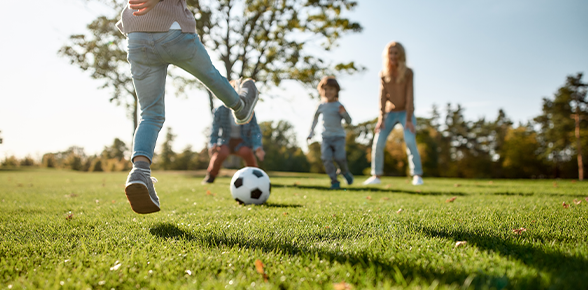At what age should a child start potty training?
If your child shows signs they’re ready for potty training, then it’s probably the right time you and your little one to embark on this journey.
They know best what’s going on in their little bodies – and while it can be hard to get them to tell you anything, there a few simple signs it might be time to take on toilet training.
When it comes to the perfect potty training age, as you’ll know with kids, not everything happens when it’s meant to. Children grow and develop at different speeds. They might have been an early walker and mastered building blocks from a young age – but they may struggle with keeping dry.
And don’t feel you need to rush into it, just because other parents are. Take your own time – making them use a potty or toilet before they are ready is likely to be as unsuccessful as trying to get them to eat their vegetables.
Generally speaking, most little ones are ready for potty training between the ages of two and three. And often girls get there a few months earlier than boys.
But if your little one decides they don’t want to ditch their nappies until they are approaching their fourth birthday, that’s fine as well. Though Amanda does suggest that parents can start educating them about potty training to encourage them to get started, as this is nearing school age.
Feeling clean is something children of all ages enjoy –they just might not know it yet. Knowing the right time to potty train your child will boost their confidence and happiness, as well as your own.
This article covers:
- Signs your child is ready for potty training
- Best time for potty training
- Five top tips to get kids ready for potty training
Signs your child is ready for potty training
The easiest way to know when to potty train your child is by picking up on the signs they’re ready. These can be as obvious as them shouting in the middle of a restaurant that they need a poo, or as subtle as them running behind the sofa every time they need to wee.
These are the most common signs your little one is ready for toilet training:
- Awareness: Becoming aware they have a wet or dirty nappy
- Realisation: Realising they’re weeing and telling you
- Physical signs: Grabbing their trousers, fidgeting or hiding somewhere when they need or do a wee or poo
- Staying dry: Having a dry nappy for at least an hour or two
- Verbalising: Knowing that they need to wee and say so, or ask if they can use the toilet
The quickest way to potty train your child is usually by starting at what is the final step – verbalising. When they tell you they need to wee or poo, you can then guide them to the next steps of what happens and what they need to do.
Most children do learn to control their bowels before their bladder by the age of two.
If you notice any of the other signs apart from verbalising, it can still be a good time to start – you just might have a few more accidents along the way. A good tip is to record any signs you see to make sure it wasn’t a one-off. If your little one keeps pulling their nappy before they do a wee – and they’re comfortable getting on and off the potty themselves –then it’s probably worth giving toilet training a try.
Best time for potty training
Getting extra help and support when potty training can help make the transition from nappies to toilets a little more straightforward. This can mean using the time of year to your advantage. When they’re not wearing as many layers (if anything at all) on warm summer days, it can be the ideal time to avoid accidents when potty training.
Summer potty training is popular for this reason. Not only do they not have to struggle getting their trousers or pants down in time, washed clothes will dry much quicker if they do have an accident.
That’s not to say you can’t try potty training on cold winter days – you just might to have plan ahead a little more.
Can you delay potty training?
Timing is everything with potty training. It’s not just about them being physically ready but also mentally ready to switch from nappies to potties. If your child is going through a big life event or experiencing disruption in their home life, it can be best to wait a while before starting.
Potty training usually works best when your little ones is feeling settled. Routines can help in this and make the process more successful, easier and quicker for all involved
It can be worth delaying potty training if:
- If your child is unwell or has been recently unwell
- You have recently moved house
- A new sibling has arrived
- Your child has recently started preschool or nursery
- Parents are separating
- You are about to go on holiday
If potty training is underway when an unexpected disruption occurs, it’s worth persisting with your new routines. Make sure you can take their potty with you wherever you go to keep things on track.
Getting kids ready for potty training – 5 top tips
The idea of using a potty will be new to your child, so it’s important you ease them into it. Before you start potty training you can gradually prepare them for it with a few simple steps:
- Talk to them – When you’re changing your child’s nappy, explain to them what’s happening so they can associate it with a wet nappy. Use bathroom language, such as ‘wee’ and ‘poo’, but in a way that makes it sound natural so they’re not embarrassed by it. Try not to say things like ‘Ugh, who did a stinky poo?’ as this can make them embarrassed about going to the toilet.
- Dress for the occasion – Start dressing your child in appropriate potty training clothes – pants that are easy to pull up and down, nothing with buttons or zips. Getting your toddler to pull them down and up before and after changing their nappy should help them associate the two acts and transfer this over to using a potty.
- Show and copy – Leave the potty in the bathroom where they’ll see it. If you have older children, letting them watch and copy can be a great help. Otherwise, when changing their nappy put the poo into the toilet and allow them to help you flush and wash their hands to start the clean routine.
- Introduce underwear – Show them that wearing underwear is something special and exciting, as some children are reluctant to stop wearing nappies. The feeling of still wearing a nappy can lead them to continue previous behaviours.
- Practice with a potty – Let them sit on the potty to get used to it, ideally around the time you change their nappy. It’s also a good idea to teach them what it’s for by mimicking its use with their toys.





